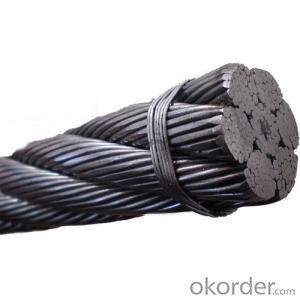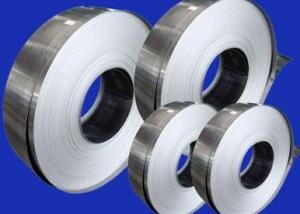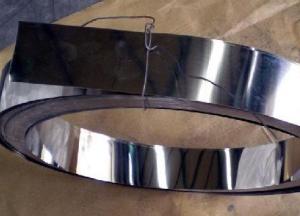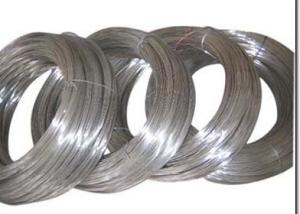Carbon Spring Steel Wire with High Tensile
- Loading Port:
- Dalian
- Payment Terms:
- TT OR LC
- Min Order Qty:
- 5 m.t.
- Supply Capability:
- 10000 m.t./month
OKorder Service Pledge
OKorder Financial Service
You Might Also Like
Item specifice
Carbon Spring Steel Wire with High Tensile
Steel Grade: | 45#,60#,65#,70#,SWRH72A, SWRH72B,80#,SWRH82B | Standard: | DIN, GB, JIS | Wire Gauge: | 0.2-13mm |
Place of Origin: | China (Mainland) | Type: | Ungalvanized | ||
Alloy Or Not: | Non-alloy | Application: | Making spring,mattress,wire rope |
Packaging Details: | Coil Packing,Z2 Packing,Z3 Packing,Spool Packing. |
Delivery Detail: | Within 10 days |
1.Diameter range:0.2-13mm
2.Main application:making spring,mattress,wire rope.
3.Standard:GB4357,DIN17223,JIS G 3521
High Carbon Spring Steel Wire Performance:
1.Diameter range:0.2-13mm
2.Main application:making spring,mattress,wire rope.
3.Standard:GB4357,DIN17223,JIS G 3521
Standard:DIN17223:
High Carbon Spring Steel Wire | |||
wire diameter(mm) | Tensile Strength(N/mm² ) | ||
Grade A | Grade B | Grade C | |
0.30 | 2370-2650 | ||
0.40 | 2270-2550 | ||
0.50 | 2200-2470 | ||
0.60 | 2140-2400 | ||
0.70 | 2090-2350 | ||
0.80 | 2050-2300 | ||
1.00 | 1720-1970 | 1980-2220 | |
1.20 | 1670-1910 | 1920-2160 | |
1.40 | 1620-1860 | 1870-2100 | |
1.60 | 1590-1820 | 1830-2050 | |
1.80 | 1500-1780 | 1790-2010 | |
2.00 | 1520-1750 | 1760-1970 | 1980-2200 |
3.00 | 1410-1620 | 1630-1830 | 1840-2040 |
4.00 | 1320-1520 | 1530-1730 | 1740-1930 |
5.00 | 1260-1450 | 1460-1650 | 1660-1840 |
6.00 | 1210-1390 | 1400-1580 | 1590-1770 |
7.00 | 1160-1340 | 1350-1530 | 1540-1710 |
8.00 | 1120-1300 | 1310-1480 | 1490-1660 |
9.00 | 1090-1260 | 1270-1440 | 1450-1610 |
10.00 | 1060-1230 | 1240-1400 | 1410-1570 |
11.00 | 1210-1370 | 1380-1530 | |
12.00 | 1180-1340 | 1350-1500 | |
13.00 | 1160-1310 | 1320-1470 | |
Picture

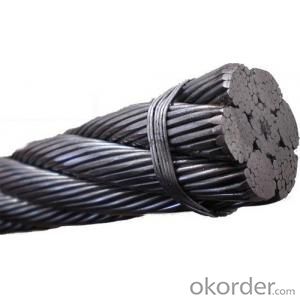
- Q:Are there any safety concerns when handling stainless steel wire?
- Handling stainless steel wire comes with certain safety concerns. Firstly, it is essential to handle it with care as it has sharp edges that can easily cause cuts or puncture wounds. Wearing protective gloves is crucial to prevent any injuries. Secondly, incorrect handling of stainless steel wire can lead to strain or muscle fatigue. It is important to use proper lifting techniques and avoid overexertion, especially when dealing with heavy or large quantities of the wire. In addition, stainless steel wire can become extremely hot during heating or certain manufacturing processes. To avoid burns or thermal injuries, it is necessary to use heat-resistant gloves when handling it. Moreover, individuals with allergies or sensitivities to nickel should take precautions as stainless steel wire may contain small amounts of this metal. Wearing gloves or using barriers to prevent direct contact with the wire is recommended for those with known nickel allergies. Lastly, there is a risk of eye injuries when working with stainless steel wire, as flying particles or sparks can pose hazards. Protecting the eyes by wearing safety glasses or goggles is essential in such situations. In conclusion, while stainless steel wire is generally safe to handle, it is important to be aware of these safety concerns and take necessary precautions to minimize the risk of accidents or injuries.
- Q:What are the different types of stainless steel wire mesh belts?
- The market offers a variety of stainless steel wire mesh belts for different purposes. These belts find common use in conveying, drying, cooling, and filtering across various industries. Here are some of the stainless steel wire mesh belts available: 1. Balanced weave belts: These belts provide exceptional stability and strength as they are constructed with alternating right and left-hand spirals. They are ideal for applications that demand high tensile strength and durability. 2. Compound weave belts: These belts feature multiple layers of wire mesh with different weave patterns, resulting in increased strength, stability, and flexibility. They are suitable for heavy-duty applications. 3. Flat wire belts: Made from flat wire spirals connected by straight cross rods, these belts offer a smooth surface, high tensile strength, and good airflow. They are perfect for drying and cooling applications. 4. Chain-driven belts: Equipped with chain-driven sprockets, these belts provide precise drive and control. They are commonly used in food processing or automotive manufacturing, where accurate movement and positioning are essential. 5. Balanced spiral belts: These belts consist of left and right-hand spirals that interlock with each other, ensuring excellent tracking and stability. They are ideal for applications requiring smooth and precise movement. 6. Wire mesh conveyor belts: These belts are frequently used in conveyor systems to transport materials or products. They come in various mesh sizes, wire diameters, and belt widths, catering to different application needs. 7. Welded wire mesh belts: These belts are created by welding individual wire strands together to form a mesh pattern. They offer high strength, stability, and resistance to heat and corrosion, making them suitable for harsh environments. 8. Ladder belts: Constructed with ladder-like wire mesh, these belts provide a flat and stable surface. They are commonly utilized in baking or drying processes where efficient airflow and heat transfer are required. Each type of stainless steel wire mesh belt possesses unique properties and advantages, tailored for specific applications. The selection of the appropriate belt depends on factors like application requirements, operating conditions, and desired performance characteristics.
- Q:Stainless steel screw 316 or 304 screw?
- 304 is the cover type stainless steel, the material composition is OCr18Ni9316L, is the austenitic stainless steel; 316 material composition is OOCr12Mo2Ti, is a kind of titanium containing low carbon stainless steel, alkali, acid fast (chlorine ion medium except).
- Q:Is stainless steel wire resistant to atmospheric corrosion?
- Yes, stainless steel wire is resistant to atmospheric corrosion. Stainless steel is specifically designed to be resistant to corrosion in various environments, including atmospheric conditions. This is due to the presence of chromium, which forms a protective layer on the surface of the stainless steel wire, preventing the penetration of corrosive elements from the atmosphere. This protective layer, known as the passive film, acts as a barrier between the stainless steel and the corrosive agents, such as moisture, oxygen, and pollutants in the air. As a result, stainless steel wire can withstand exposure to atmospheric conditions without experiencing significant corrosion or degradation. This makes stainless steel wire a popular choice for various applications, including outdoor structures, marine environments, and industrial settings where exposure to the atmosphere is a concern.
- Q:Can stainless steel wire be used for wire rope grips?
- Yes, stainless steel wire can be used for wire rope grips. Stainless steel is known for its excellent corrosion resistance and strength, making it a suitable material for wire rope grips. Stainless steel wire rope grips are commonly used in various industries such as marine, construction, and rigging, where durability and reliability are essential. The stainless steel construction ensures that the wire rope grips can withstand harsh environmental conditions and resist rust and corrosion, ensuring a long-lasting and secure grip on the wire rope.
- Q:What kind of material does stainless steel screw thread and stainless steel cold heading wire generally use?
- Stainless steel screw thread and stainless steel cold heading wire, generally use 304M, 304HC, 316, three kinds of materials, is the 300 series of austenitic stainless steel is one of the most widely used materials. Each material obviously difference is: after cold processing, the material magnetism is 316<304HC<304M. 316, the material is resistant to chemical corrosion, corrosion resistance and sea water corrosion resistance, relative to 304M and 304HC to fine.
- Q:Can stainless steel wire brushes be used for removing rust?
- Yes, stainless steel wire brushes can be effectively used for removing rust. Stainless steel is resistant to rust and corrosion, making it a suitable material for rust removal applications. The wire bristles of the brush can easily remove rust from surfaces without causing damage or scratching.
- Q:Why are the 304 stainless steel wires magnetic? And the thinner the wire, the greater the magnetism
- In addition, 304 stainless steel after cold processing, the structure of the structure will also change to martensite, and the greater the deformation degree of cold work, the more martensite transformation, the greater the magnetism. Like a lot of stainless steel wire, made straight, no obvious induction, but it is bent into a rectangular or circular, and produce some magnetic for cold bending deformation is large, especially the angle of magnetic is more obvious.
- Q:Is stainless steel wire suitable for wire rope connectors?
- Stainless steel wire, indeed, proves to be appropriate for wire rope connectors. Renowned for its resistance to corrosion, stainless steel emerges as a dependable option for outdoor and marine scenarios, wherein the wire rope might come into contact with dampness and other severe elements. Furthermore, stainless steel wire exhibits exceptional tensile strength, enabling it to endure substantial loads and establish steadfast connections. Notably, it boasts durability and longevity, guaranteeing the wire rope connectors' steadfastness throughout the passage of time.
- Q:What are the different types of stainless steel wire rope hooks?
- There is a variety of stainless steel wire rope hooks available, each designed for specific applications and requirements. Some of the commonly used types are as follows: 1. Clevis Hook: This hook has a clevis pin that can be easily attached or detached from the wire rope, providing a secure connection. It is commonly utilized in lifting and hoisting operations. 2. Eye Hook: This hook has a closed loop or eye at the end, allowing for easy attachment of the wire rope. It is frequently used when the hook needs to be permanently connected to the rope. 3. S-Hook: The S-hook, named after its shape resembling the letter "S," has a curved end used for attaching the hook to the wire rope. It is commonly employed in lighter-duty applications such as hanging signs or securing objects. 4. Carabiner Hook: Shaped like a carabiner, this hook is typically used for climbing or rigging purposes. It includes a spring-loaded gate that facilitates quick attachment or detachment of the wire rope. 5. Snap Hook: Similar to carabiner hooks, snap hooks have a wider, flat shape with a spring-loaded gate. They are commonly used in industries like marine or construction, where quick attachment and detachment are necessary. 6. Swivel Hook: The swivel hook features a rotating mechanism that allows the hook to rotate freely, preventing twisting or kinking of the wire rope. It is frequently used in lifting operations where the load may rotate or spin. To ensure safe and efficient operations, it is vital to select the appropriate type of stainless steel wire rope hook based on the specific application, load capacity, and environmental conditions.
1. Manufacturer Overview |
|
|---|---|
| Location | |
| Year Established | |
| Annual Output Value | |
| Main Markets | |
| Company Certifications | |
2. Manufacturer Certificates |
|
|---|---|
| a) Certification Name | |
| Range | |
| Reference | |
| Validity Period | |
3. Manufacturer Capability |
|
|---|---|
| a)Trade Capacity | |
| Nearest Port | |
| Export Percentage | |
| No.of Employees in Trade Department | |
| Language Spoken: | |
| b)Factory Information | |
| Factory Size: | |
| No. of Production Lines | |
| Contract Manufacturing | |
| Product Price Range | |
Send your message to us
Carbon Spring Steel Wire with High Tensile
- Loading Port:
- Dalian
- Payment Terms:
- TT OR LC
- Min Order Qty:
- 5 m.t.
- Supply Capability:
- 10000 m.t./month
OKorder Service Pledge
OKorder Financial Service
Similar products
New products
Hot products
Related keywords

